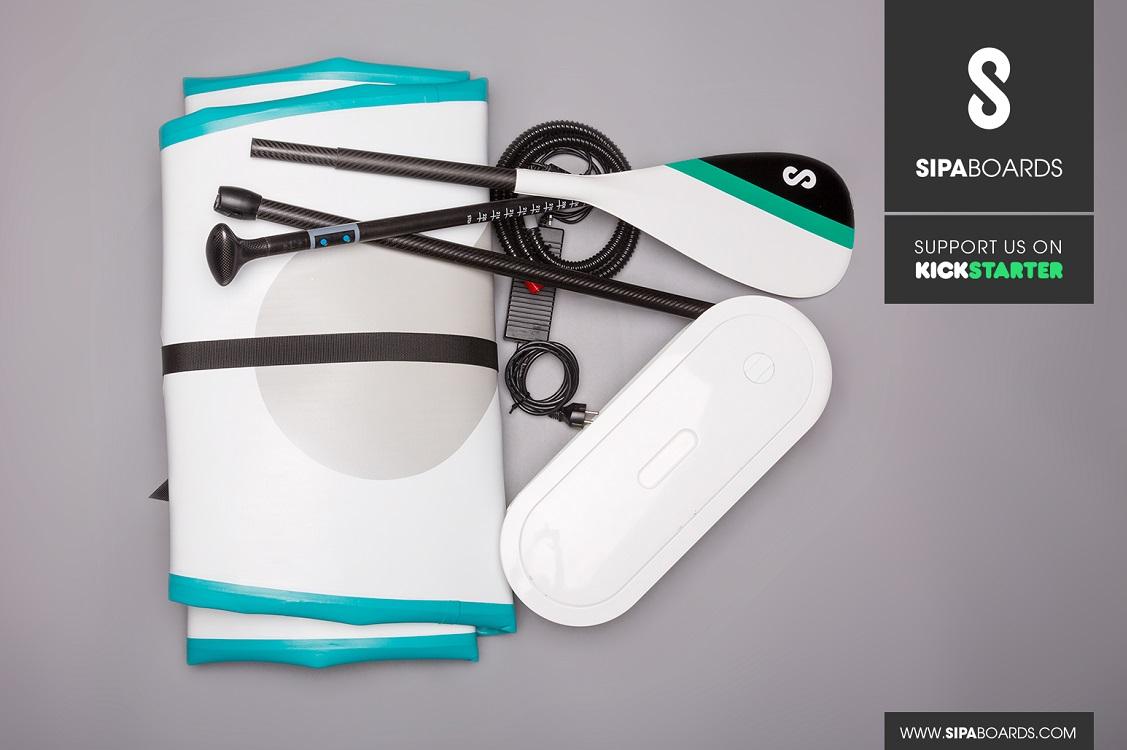Stand-up paddleboarding is awesome. Stand-up paddleboards are awful.
For many, the hassles involved in storing and transporting the massive hunks of plastic and polyurethane can suck the fun out of a wonderful pastime. Opt for an inflatable board instead and you’re stuck pumping it up yourself, or with an air pump that needs to be stowed away after it’s done its job. Hey, somebody watch my super-expensive board while I run back to the car to store the pump! Then once you’re out there, it’s on you to paddle yourself along. Hope you’re not too tired from all that lugging and pumping! Add your family and their boards into the mix and this sport can become a chore.
SipaBoard, the electric self-inflating stand-up paddleboard, aims to do away with all that — and keep you out there enjoying the water even longer. And now, the board is available for order via Indiegogo.
Forget the hassles of a hard stand-up board; the SipaBoard is no garage hog and no roof rack is required. SipaBoard shares the ease of storage common among other inflatable boards, but nullifies the annoyance of inflating the board, since it self-inflates using SipaDrive, a brushless electric jet motor. It takes about five minutes to inflate to the self-regulated pressure. It comes with its own carry bag, or fits in a backpack. Made of heavy-duty double-layered PVC, the board’s external layers become as rigid as a hard-bodied board when inflated yet remain easy to fold up.

The SipaDrive is what separates SipaBoard from the pack. It fits neatly into the middle of the board, and the intake at the bottom is covered with mesh to prevent debris or fish getting sucked in (and avoid the dismemberments that propellers can cause). Keep your fingers. Please.
Since it’s electric — powered by a rechargeable battery — you won’t leave any harmful emissions behind, and SipaBoard’s nearly silent, so you won’t terrify wildlife and get the most out of the experience, even in protected areas.
Top assistance speed is 3.5 knots, and the SipaBoard can keep it up for an hour under the weight of the average-sized male paddle-boarder. If you take it easy and use SipaBoard to cruise at about 2 knots, it’ll last about three hours. Sipaboard’s Slovenian creator, Sebastian Sitar, came up with the idea when his daughter had a hard time getting back to land during a family paddleboarding trip. Add an electric motor and around the time you (your kids, or your significant other) would have normally gotten tired, you should find a little more energy for that last push back to shore.
The controls are built into the paddle shaft and communicate wirelessly with the board. Like the rest of the Sipaboard it’s super simple; there are just two buttons for increasing or decreasing speed and a quick shut off. If you drop the paddle, the motor automatically cuts so you won’t be propelled away from SipaBoard’s very-necessary apparatus.
The board even comes with a chip — technically, it’s a smart electric self-inflating stand-up paddleboard, as if the description wasn’t a mouthful already. The chip that connects to your Android phone, iPhone, or even Pebble watch. When your phone is packed away, SipaBoard’s program tracks you and sends an alerts when you’ve hit 50 percent battery and it’s time to turn back, or else risk paddling home under your own power. You can also use your phone or Pebble watch as a view screen and remote for the board itself, controlling speed and displaying range and time traveled.
Overall, SipaBoard is likely to be the best paddleboard out for ease of use and range. You can get one yourself from Indiegogo for $940, which is quite the deal considering the SipaBoard website is selling these boards for over $2,000.
Update: The SipaBoard is now available for order.


